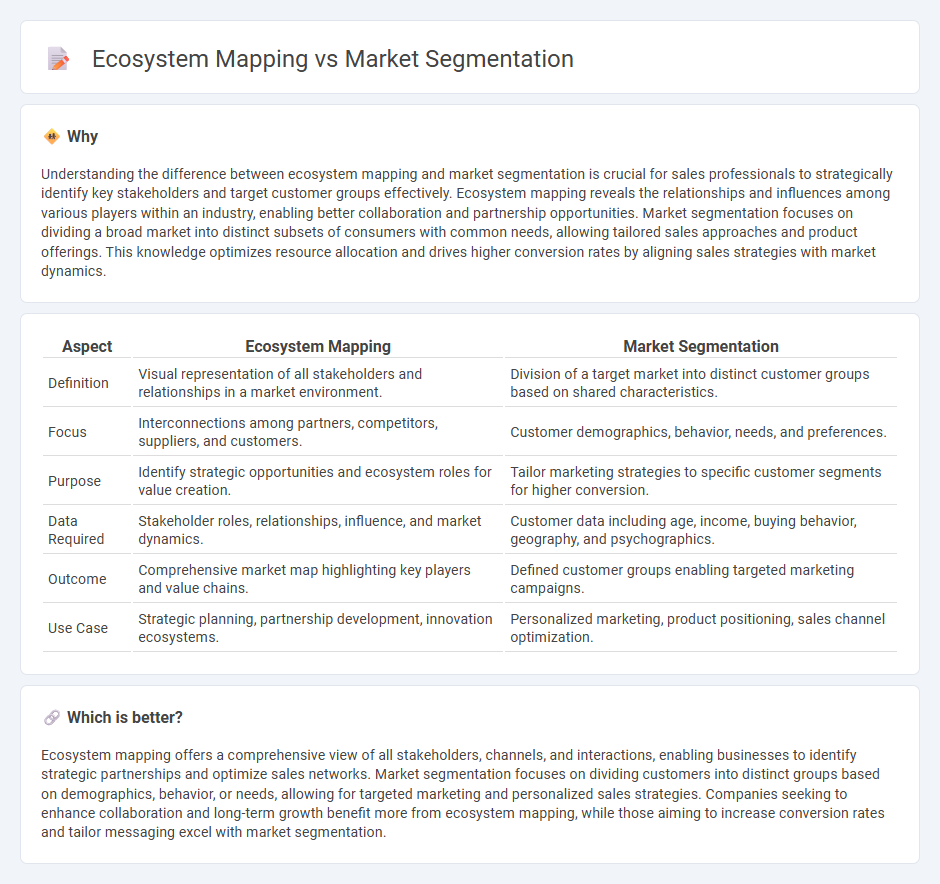
Sales success relies on understanding customer needs through ecosystem mapping and market segmentation. Ecosystem mapping identifies the broader relationships between competitors, partners, and customers, revealing strategic opportunities beyond traditional boundaries. Explore our detailed analysis to learn how these approaches can transform your sales strategy.
Why it is important
Understanding the difference between ecosystem mapping and market segmentation is crucial for sales professionals to strategically identify key stakeholders and target customer groups effectively. Ecosystem mapping reveals the relationships and influences among various players within an industry, enabling better collaboration and partnership opportunities. Market segmentation focuses on dividing a broad market into distinct subsets of consumers with common needs, allowing tailored sales approaches and product offerings. This knowledge optimizes resource allocation and drives higher conversion rates by aligning sales strategies with market dynamics.
Comparison Table
| Aspect | Ecosystem Mapping | Market Segmentation |
|---|---|---|
| Definition | Visual representation of all stakeholders and relationships in a market environment. | Division of a target market into distinct customer groups based on shared characteristics. |
| Focus | Interconnections among partners, competitors, suppliers, and customers. | Customer demographics, behavior, needs, and preferences. |
| Purpose | Identify strategic opportunities and ecosystem roles for value creation. | Tailor marketing strategies to specific customer segments for higher conversion. |
| Data Required | Stakeholder roles, relationships, influence, and market dynamics. | Customer data including age, income, buying behavior, geography, and psychographics. |
| Outcome | Comprehensive market map highlighting key players and value chains. | Defined customer groups enabling targeted marketing campaigns. |
| Use Case | Strategic planning, partnership development, innovation ecosystems. | Personalized marketing, product positioning, sales channel optimization. |
Which is better?
Ecosystem mapping offers a comprehensive view of all stakeholders, channels, and interactions, enabling businesses to identify strategic partnerships and optimize sales networks. Market segmentation focuses on dividing customers into distinct groups based on demographics, behavior, or needs, allowing for targeted marketing and personalized sales strategies. Companies seeking to enhance collaboration and long-term growth benefit more from ecosystem mapping, while those aiming to increase conversion rates and tailor messaging excel with market segmentation.
Connection
Ecosystem mapping provides a comprehensive view of all market participants, including customers, competitors, suppliers, and partners, which informs precise market segmentation strategies. Market segmentation divides potential buyers into distinct groups based on specific characteristics identified through ecosystem analysis, enhancing targeted sales efforts. This connection enables businesses to tailor marketing and sales approaches effectively by understanding the ecosystem's influence on customer behavior and preferences.
Key Terms
Market Segmentation:
Market segmentation involves dividing a broad consumer or business market into sub-groups based on shared characteristics such as demographics, behaviors, or needs to tailor marketing strategies effectively. It enables companies to target specific audiences with personalized messages, improving engagement and conversion rates. Explore detailed techniques and applications of market segmentation to enhance your marketing precision.
Demographics
Market segmentation by demographics categorizes consumers based on age, gender, income, education, and occupation to tailor marketing strategies and product offerings effectively. Ecosystem mapping involving demographics analyzes how different demographic groups interact within a business environment, highlighting relationships, dependencies, and influence patterns among participants. Explore in-depth insights on leveraging demographic data for precision marketing and ecosystem optimization.
Psychographics
Market segmentation based on psychographics categorizes consumers by lifestyle, values, personality traits, and interests, enabling tailored marketing strategies that resonate on an emotional and psychological level. Ecosystem mapping, conversely, provides a broader visualization of relationships among stakeholders, technologies, and environments, highlighting how psychographic factors interact within a complex web of influences. Explore in-depth insights to optimize your marketing approach by understanding these complementary frameworks.
Source and External Links
Market segmentation - Wikipedia - Market segmentation is the process of dividing a consumer or business market into meaningful sub-groups (segments) based on shared characteristics, aiming to identify profitable segments for targeted marketing strategies.
What Is Market Segmentation? Definition, Example, and Types (2024) - Market segmentation involves dividing a target market into smaller groups sharing similar needs, with common types including demographic, geographic, behavioral, and psychographic segmentation.
What is market segmentation? | Overview and examples - Market segmentation breaks down a broad audience into subsets with common characteristics, needs, and behaviors, allowing marketers to tailor messages and campaigns to each specific group.
 dowidth.com
dowidth.com